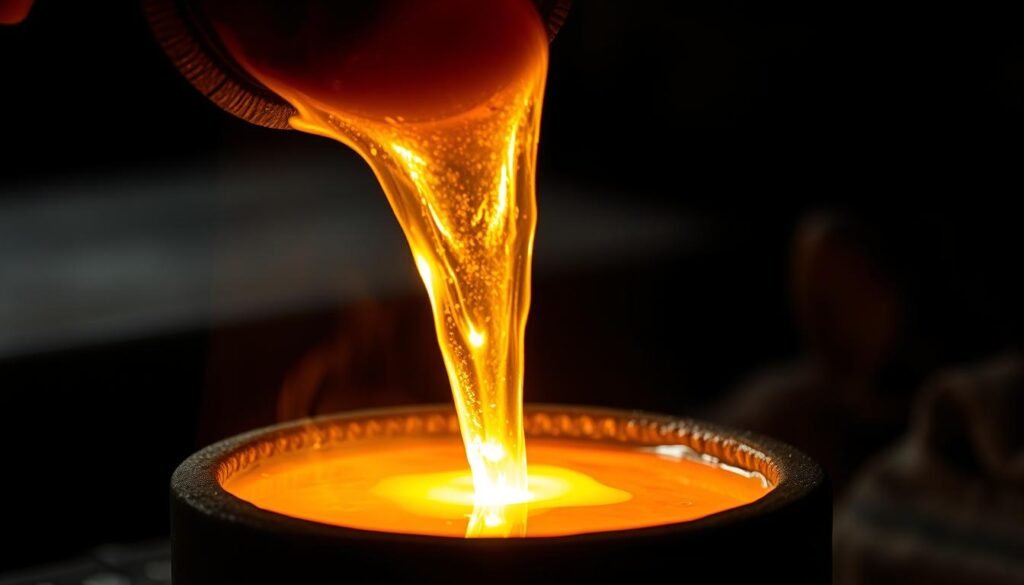The melting of precious metals is important for jewelry, coins, and valuable items. It is the key to success.
The Melting process strongly influences purity and quality. Precise temperature control is important for great results.
The right melting temperature is crucial for quality. By understanding the melting point, one can work precisely.
Melting point of gold decoded
The melting point of gold is at 1064 °C. This is important for manufacturing. Gold is easy to process because it doesn't need to melt at very high temperatures. But there are special requirements for production.
Pure gold (24 karat) has a very important melting point. You need to know exactly when it melts to make jewelry. In gold alloys, the melting point changes depending on which metals are added. For example, gold with silver or copper melts faster.
1064 °C: What it means for manufacturing
When producing gold products, you need to know the melting point precisely. A correct melting point ensures high quality. Here are the melting points of various gold alloys compared to pure gold:
| Gold alloy | Melting point (°C) |
|---|---|
| Pure gold (24 karat) | 1064 |
| 18 Karat Gold (75% Gold) | 925-950 |
| 14 Karat Gold (58.31% pure gold) | 880-900 |
As the table shows, the melting point decreases with less gold. This affects the processing and the quality of the products.
Gold in electronics
In electronics, gold is very important because of its electrical conductivity and durability.  The melting point must be precisely controlled because gold is used in thin wires or solder joints.
The melting point must be precisely controlled because gold is used in thin wires or solder joints.
Gold is ideal for contacts and connections in electronic components.
The electronics industry utilizes gold's unique properties. This allows manufacturers to make their products more reliable and efficient.
Analyze material behavior
The behavior of gold at high temperatures is important for precise manufacturing.
Gold remains stable, making it ideal for demanding applications.
When heated and cooled, gold changes. These changes can be controlled to achieve the best results.
Important factors include thermal expansion, viscosity, and surface tension.
| Property | Stability at high temperatures | Gold remains stable even near its melting point. This is important for fine jewelry or precise parts. |
|---|---|---|
| Value at 20°C | 19,3 | 17,3 |
| Value at 1064°C | 314 | 170 |
| Density (g/cm³) | – | 1140 |
Thermal conductivity (W/mK)
Influence on part quality
Contaminants or air inclusions can impair quality. High-purity gold and vacuum or protective gas atmospheres help minimize these issues.

Precision manufacturing of gold requires a deep understanding of material properties. Controlling parameters can improve quality.
Tool strategies for gold
Processing gold requires special tools and techniques. This keeps the quality of the final product high. Gold is a precious metal that must be handled carefully.
Precision tools are essential for precise work with gold. There are traditional tools and modern CNC machines. Crucibles and furnaces that withstand high temperatures and can be precisely controlled are also important.
Precision tools
Choosing the right tools is very important. Goldsmith tools must be robust and precise. This allows for the creation of complex shapes and designs.
- Traditional goldsmith tools for craftsmanship
- Modern CNC-controlled machines for precise and complex shapes
- Crucibles and furnaces for controlled heating and cooling
Cooling techniques
Proper cooling is very important for the quality of gold. It influences the crystal structure and mechanical properties. There are various cooling methods, from slow cooling to rapid quenching.
"Controlling the cooling rate is crucial for achieving the desired properties of gold."
Gold recycling is important for sustainable gold processing. It requires special melting techniques to remove impurities. This keeps the recycled gold pure.
Application-specific advantages
The melting point of gold is very important. It plays a major role in electronics and medical technology. Gold is ideal for circuit boards and microchips because of its electrical conductivity and low melting temperature.
Conductivity and melting point
In electronics, gold is used because of its conductivity and melting point at 1064 °C. It is used for contacts and switches. The melting process is very precise.
Use in medical technology
In medical technology, gold is very valuable because of its biocompatibility and corrosion resistance. It is used for dental restorations and implants. Proper processing and control of the melting point are important.
Corrosion resistance
Gold is highly corrosion resistant. This makes it ideal for aggressive environments.
New technologies improve the precision and efficiency in processing gold. As a result, gold remains an important material in many industries.


